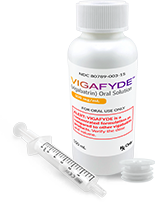DOSING AND ADMINISTRATION


VIGAFYDE™ is the first and only liquid vigabatrin formulation
Ready-to-use. No mixing required and is designed to:
- Provide a consistently correct concentration
- Help eliminate mixing errors
- Limit risk of contamination*
Dosing
The VIGAFYDE dosing regimen depends on the patient’s weight.
VIGAFYDE is a concentrated, 100 mg/mL oral solution intended for oral use only. Verify the strength and the dose of the product prior to prescribing, dispensing, and administering.
VIGAFYDE should be withdrawn if a substantial clinical benefit is not observed within 2 to 4 weeks. If, in the clinical judgment of the prescriber, evidence of treatment failure becomes obvious earlier than 2 to 4 weeks, treatment should be discontinued at that time.
Infant Dosing Table
Volume of the 100 mg/mL dosing solution that should be administered as individual doses in infants of various weights
| Weight (kg) |
Starting dose (50 mg/kg/day) |
Maximum dose (150 mg/kg/day) |
|---|---|---|
| 3 | 75 mg (0.75 mL) twice daily | 225 mg (2.25 mL) twice daily |
| 4 | 100 mg (1 mL) twice daily | 300 mg (3 mL) twice daily |
| 5 | 125 mg (1.25 mL) twice daily | 375 mg (3.75 mL) twice daily |
| 6 | 150 mg (1.5 mL) twice daily | 450 mg (4.5 mL) twice daily |
| 7 | 175 mg (1.75 mL) twice daily | 525 mg (5.25 mL) twice daily |
| 8 | 200 mg (2 mL) twice daily | 600 mg (6 mL) twice daily |
| 9 | 225 mg (2.25 mL) twice daily | 675 mg (6.75 mL) twice daily |
| 10 | 250 mg (2.5 mL) twice daily | 750 mg (7.5 mL) twice daily |
| 11 | 275 mg (2.75 mL) twice daily | 825 mg (8.25 mL) twice daily |
| 12 | 300 mg (3 mL) twice daily | 900 mg (9 mL) twice daily |
| 13 | 325 mg (3.25 mL) twice daily | 975 mg (9.75 mL) twice daily |
| 14 | 350 mg (3.5 mL) twice daily | 1050 mg (10.5 mL) twice daily |
| 15 | 375 mg (3.75 mL) twice daily | 1125 mg (11.25 mL) twice daily |
| 16 | 400 mg (4 mL) twice daily | 1200 mg (12 mL) twice daily |

Note: Not actual size. Syringe and bottle adapter provided by pharmacy.
Additional Important Dosing Considerations
Use the lowest dosage and shortest exposure to VIGAFYDE consistent with clinical objectives.
VIGAFYDE is primarily eliminated through the kidney. Information about how to adjust the dose in infants with renal impairment is unavailable.
If a decision is made to discontinue VIGAFYDE, the dose should be gradually reduced.
If switching between other vigabatrin products and VIGAFYDE, ensure the correct volume for the correct dosage is prescribed, dispensed, and administered.
How to Give the Ready-to-Use VIGAFYDE Dose
A specialty pharmacist will review how to prepare and give the VIGAFYDE dose with the caregiver. You may review this video with the caregiver so they understand the importance of giving the VIGAFDYE dose correctly.

